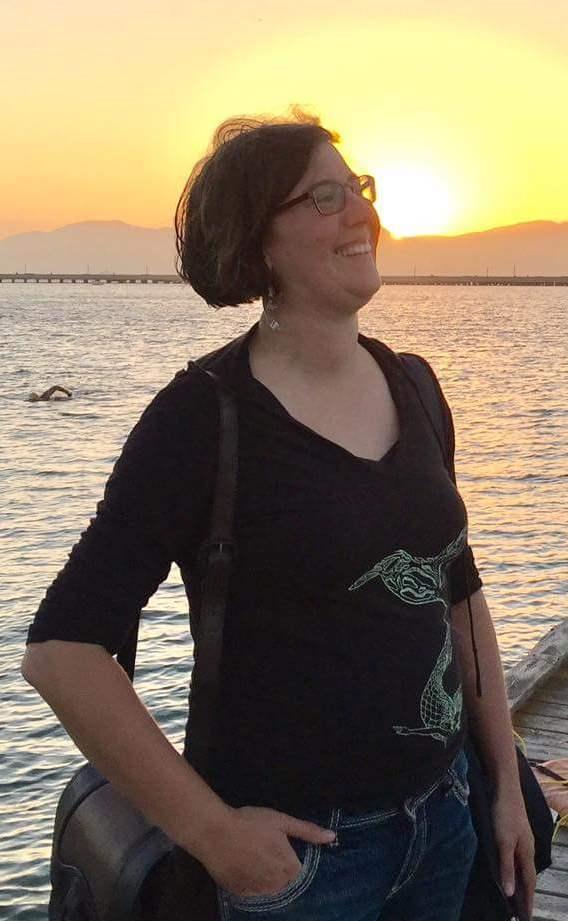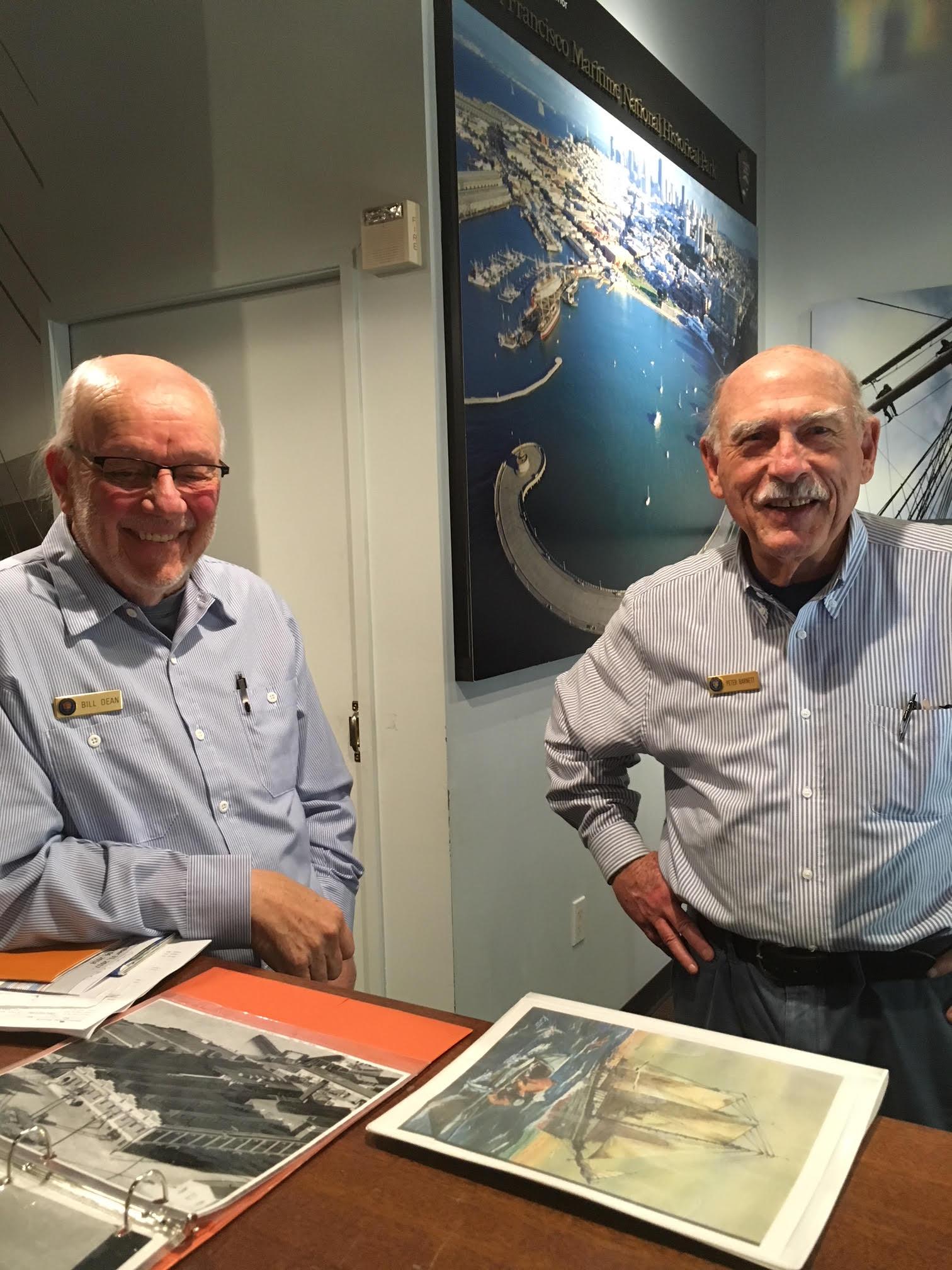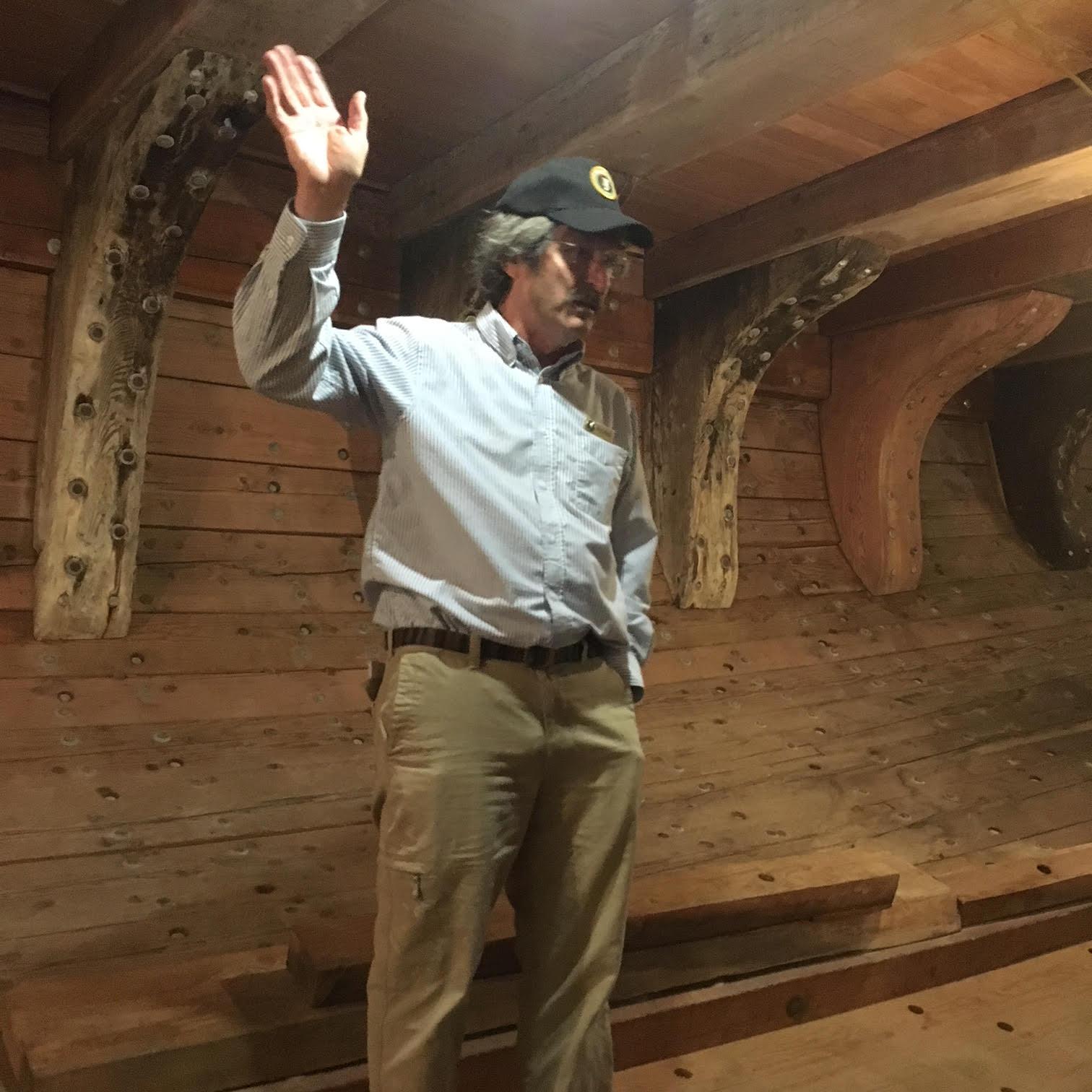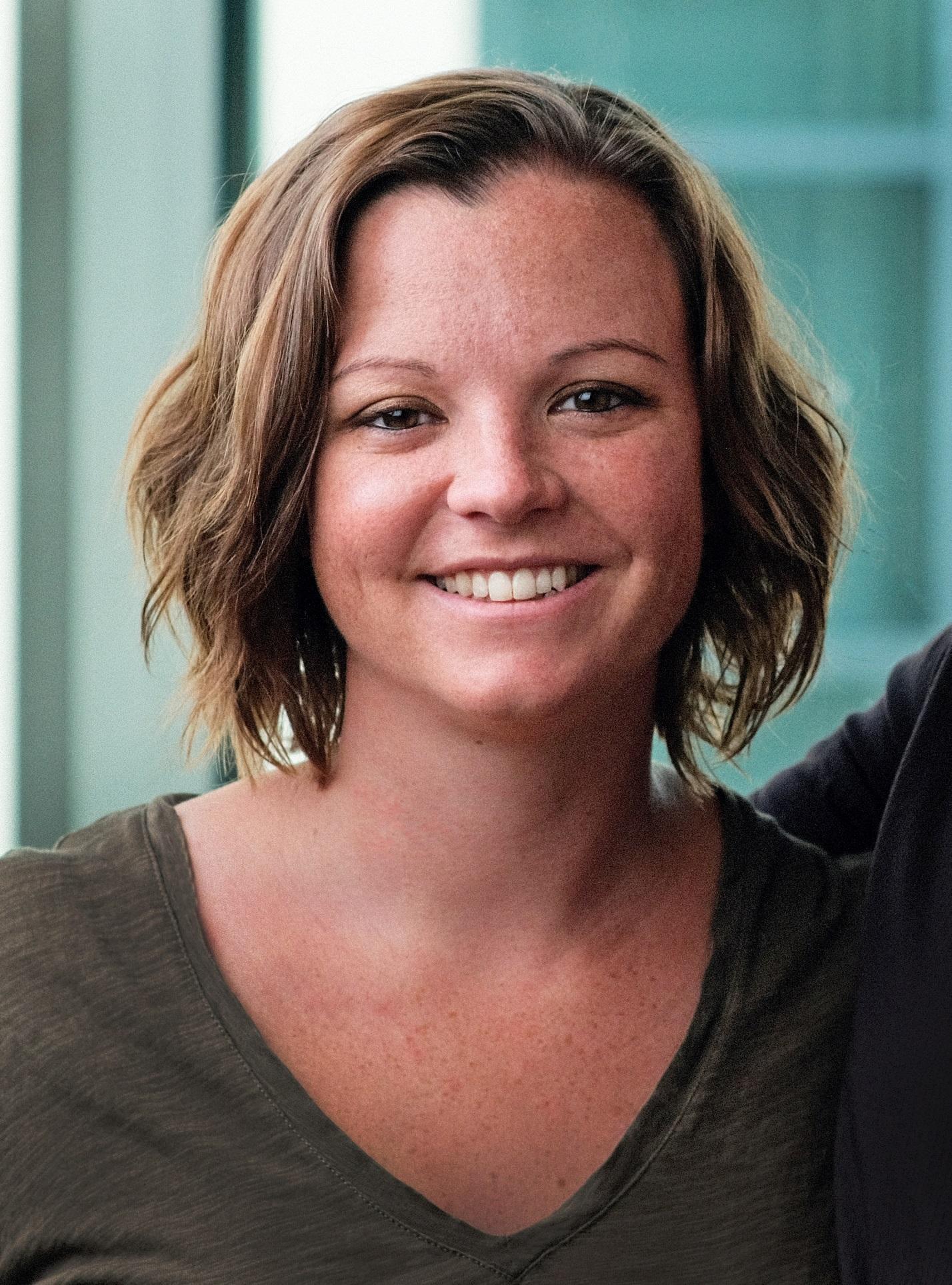San Francisco Maritime National Historical Park (SFMNHP) has more than 250 active volunteers, including interpretation docents who help the national park accomplish its goals. Volunteer projects at a maritime historical park can be truly unique! These range from building and maintaining small boats, rigging tall ships, to interpreting the extensive maritime collections.
We are currently hiring interpretation and education docents to work in the Visitor Center, the Maritime Museum Building, on the Hyde Street Pier and on historic ships (no experience necessary). We offer many training and field trip opportunities throughout the year based on docent interests, including the upcoming Annual Docent Training on June 3 and June 5. To give you an idea of what the volunteer work is like, we recently asked a few of the docents about their experiences.

Sun setting over Aquatic Cove where Docent Ilana stands on the dock of one of her two swim clubs.
Tell us about yourself, and how you came to volunteer as a docent at SFNHP?
Ilana: I became a docent because I wanted to learn more about the history of the Aquatic Park area as well as learn about the historic ships at Hyde Street Pier. I have been an open water swimmer in Aquatic Park for many years, but one day realized I knew little about the beautiful ships that add so much character to my favorite “pool”. By becoming a docent I knew that I would have to do some homework so that I could learn the stories behind the ships!
How does volunteering help you or society?
Ilana: I love national parks and I love meeting people. I hope that as a docent I am giving something back to the National Park System which gives so much to me. I also believe that the world benefits from more face to face interactions between diverse groups of people. Every time I have a volunteer shift at the park I get to speak to people from all over the place! At the Visitor Center, I’ve had long chats with local seniors who might not have that many other people to talk to, I’ve presented youth from around the world with Junior Ranger badges, and really every time someone comes up to the desk it’s a chance to have a meaningful connection with another person.
What makes a good docent?
Ilana: A good docent should be someone who likes to learn new things, someone who can work both independently and as part of a group, and who has a good sense of humor and a willingness to adapt and be flexible.

Docents Bill (left) and Pete (right) are pictured in the Visitor Center. Bill is researching the maritime words that show up in our everyday speech, and Pete leads a tour on the C.A. Thayer, a 19th century coastal lumber schooner.
Tell us about yourself and what you do.
Bill: I’ve been a docent since 2015. I was born and raised in Chicago, and have lived on the East Coast from New England to North Carolina, and also Southern California and Nevada. I now reside in Oakland and enjoy taking BART and the F line streetcars when I come to the park bi-weekly.
Why did you become a docent?
Bill: I have always, since childhood been involved with and interested in boating. Even took courses in boat building at San Francisco Maritime in the early 1990’s when they were run in conjunction with Wooden Boat magazine. That piqued my interest in the park and the collection of ships and small craft. I thought it would be fun to be involved in working as a docent.
What should people expect when they become a docent?
Bill: If you become a docent remember it is a commitment... realizing that others are dependent on you means you have to arrange your schedule to make sure that if at all possible you fulfill your obligation.
About Pete:
Pete is a docent in the Visitor Center, a member of the Thayer Team and Audience Centered Interpretation group, as well as a docent at the Oakland Museum. He’s a Native Californian with family roots that go back to before 1800. He recently retired as a forensic scientist.
Why do you like being a docent?
Pete: In this and my other volunteer activities, I feel that I get more from the people I meet and talk with than they probably do from me. It’s a fantastic way to find out about people and at the same time give them something of value, even if it’s just information.

Docent Gregg is pictured in the hold of the C.A. Thayer, an early 19th century coastal lumber schooner berthed at San Francisco Maritime NHP. Gregg staffs the Maritime Museum Building, and is a part of the Thayer Team, providing interpretation of the schooner and maritime history of the Pacific Coast.
Tell us about yourself and how you came to be a docent at SFMNHP..
Gregg: I first visited the then-San Francisco Maritime Museum in the summer of 1968. As a lad of 15, it was a magical place, with cases and cases of "stuff" stacked floor to ceiling on the main floor and the second floor. You couldn't see the murals or the tiles, but who cared? I came back every time I was in San Francisco then lagged until my 60th birthday in 2012. What a change! So when I retired and my wife was looking for something for me to do, the maritime park beckoned. It's still a magical place!
What was the most surprising experience you've had as a volunteer?
Gregg: Too many to count, and they are all great. People have asked, "Where's my grandfather's scrimshaw collection?” "Where's my great uncle's diving suit collection?” "Do you all want an early 20th century wooden lifeboat?” "Where can I drop off some black & white sailing photos from the late 1800's that I found in my Dad's attic?” "I'm Joe Rosenthal's daughter" (American photographer of Raising the Flag on Iwo Jima. Wow!). "My grandfather sailed on the C A Thayer" (double wow!).

Picture of Visitor Center Docent Beth who recently moved to San Francisco with her husband. As an officer in the Army Reserve she has served to assist with the re-energizing of Puerto Rico and to help with the recovery of the fire-damaged communities of Sonoma.
Tell us about yourself, and how you came to be a volunteer at SFNHP?
Beth: I am a US Army Reservist on orders working for the US Army Corps of Engineers. This assignment brought my husband and me to San Francisco last summer and we plan to make the city our new home. While exploring Fisherman’s Wharf, we stumbled upon the national park and had a great time on our visit. I saw a sign that said "Deck Hands Wanted!" and knew I had found the volunteer opportunity I had been looking for.
What was the best volunteer experience you ever had?
Beth: Swearing in Junior Rangers is the absolute best part of being a docent. National park visitors are the best tourists and they love to see and learn and do everything the NPS has to offer. I myself learn so much about my new city from our visitors and I love getting to be a part of their experience at the San Francisco Maritime NHP.
About Shirley:
Shirley is a docent at the Visitor Center and member of the Audience Centered Interpretation (ACI) group. She teaches at one of the Bay Area colleges. As a member of ACI, she and the docent coordinator will collaborate to create the curriculum for the next ACI cohort in July.
What are the benefits of volunteering?
Shirley: In my lifetime, I have volunteered for many organizations. Volunteering provides many avenues to personal growth, skills-building, education, and expanding knowledge. It widens perception and appreciation for people, perspectives, cultures, approaches to problem-solving, and how to handle a variety of opinions and circumstances. Each organization you serve broadens your ability to thrive in different environments. As you help and educate others, they help and educate you in return. You develop new knowledge, skills and pathways that help you better understand your world.
What are some of the dos and don’ts of volunteering?
Shirley: A long time ago, as a VISTA (Volunteers in Service to America) volunteer, one of the most valuable lessons I learned was to become part of the culture in which you serve. Do not bring to your service a “missionary” attitude that you are there to save the world, the culture, the organization or whatever. That attitude is one that is both patronizing and ultimately can work against what you, the organization and those with whom you collaborate and serve, wish to accomplish. Instead, work “with” and not “for.” Share your knowledge and accept knowledge from the people and communities with whom you work so that everyone benefits and grows. Those core lessons were ones that have served well in many situations.
